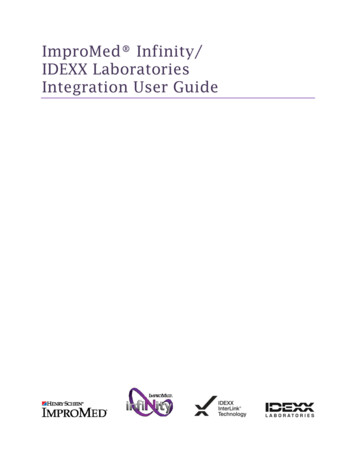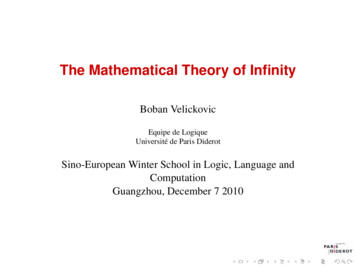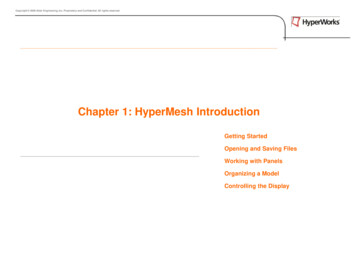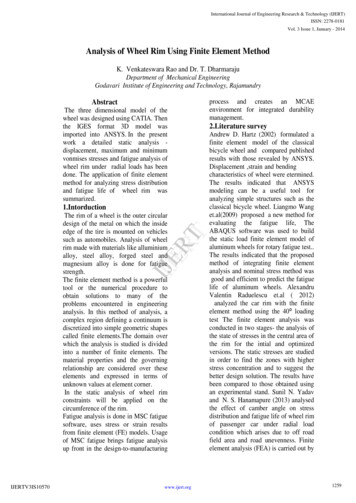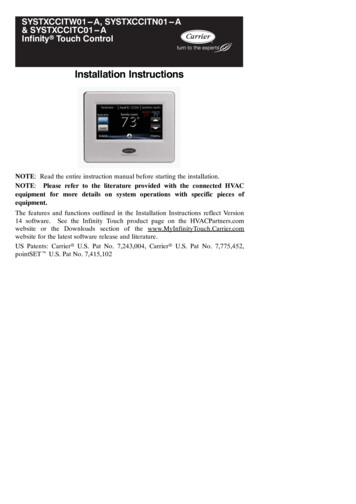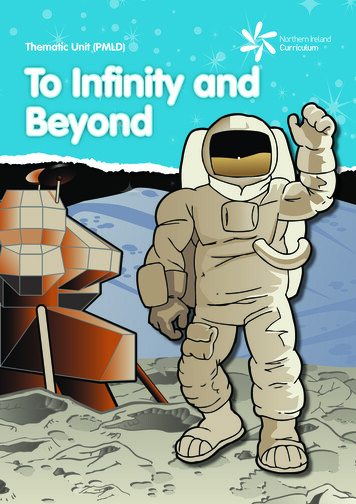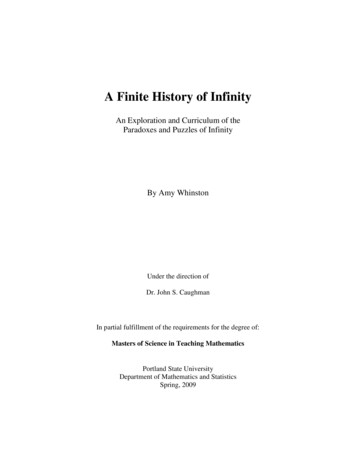
Transcription
A Finite History of InfinityAn Exploration and Curriculum of theParadoxes and Puzzles of InfinityBy Amy WhinstonUnder the direction ofDr. John S. CaughmanIn partial fulfillment of the requirements for the degree of:Masters of Science in Teaching MathematicsPortland State UniversityDepartment of Mathematics and StatisticsSpring, 2009
Abstracti
Acknowledgementsii
Table of ContentsAbstract . . iAcknowledgements . .iiPart One: An Exploration of the Concept of InfinityChapter 1: Introduction – Why Infinity? . . 2A personal reflection on my own encounters with the concept of infinitythroughout my life, education, and employment as a teacher.Chapter 2: Exploration – A History of Infinity . . . . 12The Ancient Greeks and RomansInfinity in Jewish and Christian TraditionsLeibniz and Newton and CalculusModern Conceptions of the UniverseChapter 3: Exploration – Zeno and Infinity . . . . 29Under RevisionChapter 4: Exploration – Cantor and the Continuum . . . 30The Diagonalization ArgumentThe Relationship between Countability and the ContinuumHigher dimensions do not have higher cardinalityHigher Orders of InfinityThe Continuum HypothesisPart Two: Teaching Aspects of Infinity to StudentsOverview of the Curriculum . 45Activities for the Classroom. . 46Activity 1 – Making infinity understandable to young students . . 46Activity 2 – Dividing by zero, part I . 49Activity 3 – Dividing by zero, part II . . 79Activity 4 – Repeating decimals . 79Activity 5 – Making infinity with 4 fours . 79Activity 6 – Infinity and squares . . 79Activity 7 – Angles of shapes with different numbers of sides . . 79Activity 8 – Rational functions . 79Activity 9 – Compound interest . . 79Activity 10 – Half Life . . 79iii
Activity 11 – Estimating pi . . 79Activity 12 – Markov chains . 79Activity 13 – Areas under curves . . 79Activity 14 – Infinitely long solids of rotation . 79Activity 15 – Infinity minus infinity, part I . . 79Activity 16 – Infinity minus infinity, part II . 79Activity 17 – Discussions about infinity . . 79Activity 18 – Infinity in art . . 79Activity 19 – Writing about infinity . . 79AppendicesOverview of Presentation . 161Just For Fun . . 170Bibliography . . 180Tables and Materials . . 195iv
Part One:An Exploration of the Concept of InfinityThe infinite! No other question has ever moved so profoundly the spirit of man;no other idea has so fruitfully stimulated his intellect; yet no other concept standsin greater need of clarification than that of the infinite.- David Hilbert (Maor, p. 7)Infinity is where things happen that don’t.-1anonymous schoolboy (Maor, p. 67)
Chapter 1: Introduction – Why Infinity?The idea of infinity has been a source of interest, fascination, and occasionallyfrustration for me as long as I can remember. Infinity seemed to pop up everywhere; itcame up not just in mathematics, but also in science, art, and religion.When I was about six, I wanted to know what the highest number was. Mymother explained to me that there was no highest number, that whatever number someonecame up with, you could always add one. Although I understood that she was right, itstill bothered me. Then a relative gave me a book called something like “The Big Bookof Answers” which had questions that children ask and their answers. One of thequestions was “What is the largest number?” The book said it was a googol, written as a1 with 100 zeros after it. Triumphantly, I showed this to my mother who explained that agoogol was the largest number with a new name, but that a-googol-and-one was also anumber. I knew, even before I showed her the book, that that was what she was going tosay. I knew she was right, but it still annoyed me.The fitting room in the clothing store where my mother would take me hadmirrors on all four sides of the cubicles. You could look in the mirror in front of you andsee your back. If I looked at the right angle I could see my back, the reflection of myfront reflected in the mirror in back of me, and so on. I would wiggle my arms to see allthe reflected arms do a perfectly synchronized dance. The idea of my reflection bouncingback and forth forever, giving me infinitely many limbs, intrigued me. A few times I2
tried counting to see how many arms or shoes I could identify, but my mother gotimpatient waiting for me.My grandparents had a set of babushkas, or Russian nesting dolls. I’d open thefirst doll and take out the second doll, inside the second doll was the third doll, and so on.There were mostly about seven dolls, and the last one did not open. Although I realizedthat these could not go on forever, I was always disappointed when I came to the lastdoll.I don’t remember what brand of cookies we bought years ago, but the box had apicture of itself on the package. The picture of itself included the picture of itself, whichincluded the picture of itself. At some point in the center it just became some gray spots,but I liked to imagine the pictures going on forever, becoming infinitely small. This iscalled the “Droste Effect”, named for a brand of Dutch cocoa whose box had a picture ofitself on it. Other food packages did this as well. Pink Floyd’s record “Ummagumma”had an album cover like this.3
(Droste photograph from Wikipedia, Droste Effect,http://en.wikipedia.org/wiki/Droste effect. Land O’ Lakes photograph from Wikipedia,Land O’ Lakes, http://en.wikipedia.org/wiki/Land O%27Lakes. Pink Floyd Albumphotograph from Wikipedia, Ummagumma, http://en.wikipedia.org/wiki/Ummagumma)I read about a woman who liked to have her picture taken with celebrities. Thefirst time she had her picture taken with one, she saved the picture. The second time, sheheld up the first picture while the second picture was being taken. She held up the secondpicture while the third one was taken. I imagined what the pictures would look like, asthe image from the first picture got smaller exponentially.Stephen Colbert, host of The Daily Show,has a portrait of himself standing by his fireplacedrawn every year. He then puts the painting on thefireplace mantle, and it gets drawn into the nextyear’s portrait. (“Second Year Portrait” fromMSNBC website, http://www.msnbc.msn.com/id/15976666/. Third Year Picture fromSmithsonian National Picture )Norman Rockwell painted a picture he called“Triple Self-Portrait”. (Photo from The ell/rockwell self.jpg.html) It is a picture of himself looking in themirror as he draws himself. The picture shows his imagethree times: once is himself, one is his reflection in the4
mirror, and one is the picture he is drawing. I think that it would have been nice ifsomeone had taken a photograph of Rockwell painting this picture, giving us four imagesin the picture. Years ago, I thought this could be continued for many iterations, but then Irealized that someone else would have had to hold the camera to take the picture,breaking the chain of Rockwell images. (Even if he used a camera with a timer, he couldnot be at the camera and at the easel at the same time.)I have always loved theartwork by M.C. Escher, an artistwho used the concept of infinity inmany of his drawings. His picture“Development” shows a mass oflizards, getting larger as they comeout from the center. (Picture fromwebsite M.C. Escher, http://www.cord.edu/faculty/andersod/escher.html) I can imaginethe lizards getting infinitely small as get into the center of the picture. Other pictures,like “Fish” have the largest animals in the middle, and it looks like they get infinitelysmall as we go towards the outside. (picture from website MC Escher: Infinity,http://pirate.shu.edu/ scher’s picture “Drawing Hands” gave me a differenttype of feeling of infinity. (drawing from Drawing Hands onWikipedia, http://en.wikipedia.org/wiki/Drawing Hands .) Theleft hand is drawing the right hand, as the right hand is drawing5
the left hand. The left hand can not draw the right hand until the right hand finishesdrawing the drawing the left hand, but the right hand cannot draw the left hand until it isdrawn. And so on.Is space infinite? My brother and I wanted to know. I had trouble with the ideaof an infinite universe. We learned that there are stars everywhere in the universe. So ifthe universe is infinite, there must be infinitely many stars. But I felt like the number ofstars had to be finite, no matter how large it is. Moreover, if the universe is finite, what isthe edge? Could I travel to the edge of the universe and not be able to go any farther?My mother told us that Einstein said that space curves around on itself, but she didn’treally understand how. This also frustrated me, much more so than the fact that there isno largest number.Years later, I learned about the Big Bang theory, that the universe is expandingand everything is getting farther away from each other like raisins in raisin bread as thebread rises. However, parts of the universe could only move at a finite speed. If the BigBang occurred fourteen billion years ago, objects could only be fourteen billion lightyears from the center of the universe. That still left me with the question of what I’d findif I went to the edge of the universe. (This ignores the fact that I could not go faster thanthe speed of light so I would never catch up with the edge.)I have felt somewhat less frustrated ever since I read “The Boy Who ReversedHimself” by William Sleator. Omar, a boy in the book, guards the two dimensionaluniverse that exists on the surface of a three dimensional sphere. The two dimensionaluniverse is finite, limited to the surface area of the sphere, but their space curves around6
on itself, and if someone began travelling, they could go in a straight line around thesphere and end up where they began. Although I cannot picture it, I think we live on thesurface of a four dimensional hypersphere. If we travelled long enough and fast enoughin a straight line, we would circle around in the fourth physical dimension. Theexpansion of the universe means the hypersphere is getting larger.Is time infinite? If the universe began with the Big Bang, did time exist beforethat? Will time exist after the Big Crunch, assuming there will be one? And if there is noBig Crunch, will time continue forever? I don’t know the answers to these questions.I’m also not sure whether the idea of time passing involves science or philosophy. Manyscientists say that someday all the energy in the universe will have broken down as far asit can, and the universe will no longer be able to sustain life. If there is no life, does timepass? If all the energy has broken down, will electrons continue to orbit the atom’snucleus, the only way to really keep time?As I child, I did not encounter much work with infinity in math classes. Theclosest I came was when my teacher told us we could not divide by zero. This did notbother me. I found that division and fractions made sense if I looked at them as splittinga number of cakes among a number of people. 8 4 2 means that if you split eight cakesevenly among four people, each person would get two cakes. 8 0 is meaningless; it askshow many cakes each person would get if you split eight cakes among zero people.Since there are no people to get any cake, there is no answer. I did not feel that the7
answer should be zero or infinity, as there wasn’t anyone getting zero cakes or infinitecakes.We did look at repeating infinite decimals. I think I was in fourth or fifth gradewhen we learned how to do long division for decimals that would repeat and never end. Iwas in eighth grade when I learned how to take a repeating decimal and turn it into afraction. I remember my teacher showing us thatis equal to 1.We covered compound interest briefly in high school. We found that the moreoften interest is compounded, the more interest you get. In class we looked at interestcompounded yearly, quarterly, monthly, and daily. That evening I jokingly said to mymother that on my bank account, I wanted my interest compounded infinitely manytimes. I was surprised when she told me that this was possible to calculate, and that Iwould learn how when I learned calculus.When we studied the circumference of a circle, we were just told the value of pi.I think it would have been interesting to try to estimate it first by inscribing andcircumscribing polygons with a circle, and increasing the number of sides of the polygonsto get closer to the circle.The first class I took that really used infinity at all was high school calculus. Welearned limits in the first semester. Our teacher showed us that, if we divide a constantby a variable, as the variable approaches zero, the division approaches infinity (ornegative infinity). If the variable approaches infinity, the fraction approaches zero. Wealso learned to look at what other functions would do as the variables approaches infinity.In later calculus classes, we learned how to calculate the area under a curve usinginfinitely many inscribed or circumscribed rectangles. We saw shapes that were8
infinitely long, yet had finite area. We added up infinitely many positive numbers andgot a finite sum. What at first seems like a contradiction is possible. I was sucked into alifetime of loving math.It was not until after I received my BS in mathematics and was taking some matheducation classes at a different university that I learned that there are different sizes ofinfinity. This is very counter-intuitive at first, but the professor made it make sense. Atleast I left the class understanding the difference between the infinite which is countableand that which is not.Years later I took a writing class called “writing about ideas”. I thought it wouldbe a class about persuasive writing.The class involved writing about scientific ideasand making them understandable to non-science people. For my term paper, I decided Ishould write about different sizes of infinity. I did some reading on my own and listenedto some explanations from some of the math tutors on the third floor of Neuberger Hall(at a third university) to understand why we need different levels of uncountable infinity.For two years, while I taught math at Benson High School in Portland, I was thefaculty advisor for the math club. I then spent a year teaching middle school and highschool math at Deering School, in Deering, Alaska, and was in charge of a once-a-daymath elective. For both the math club and the math elective, I was free to work onwhatever I wanted with the students. I included some work that involved infinity,including looking at Zeno’s paradoxes, the Hilbert Hotel, and different sizes of infinity.This gave me a chance to work with students at different levels with varyingdegrees of interest in math. The math club at Benson included a wide variety of students:9
some students just showed up because their teacher gave them extra credit points for it,some were mildly interested, and one boy loved math and wanted to learn all I couldteach him at as high a level as I could. At Deering School, the math elective was set upso students could get another credit in math if they needed it, was a combination of highschool and middle school students, and was not based on ability or interest. In bothgroups, I found that topics involving infinity were among those that interested thestudents the most. I’m sure it is because infinity is somewhat incomprehensible that it isso interesting.At Deering School and at Bartlett High School in Anchorage, AK, the classes Itaught included geometry. I included some topics involving infinity in the curriculum,including finding the shaded area in a shape with an infinite shading pattern, finding thearea of a shape with a given circumference as the number of sides increases, and theangle measure of a regular polygon as the number of sides increases.Currently, I teach college algebra and statistics at the University of Alaska,Anchorage, as well as college algebra and trigonometry at the Elmendorf branch ofEmbry Riddle Aeronautical University. The curricula of these classes all involveinfinity: what happens to rational functions as x approaches infinity, calculating thecircumference of a circle using inscribed and circumscribed polygons with increasingnumber of sides, interest compounded continuously, probability distributions withinfinitely many different outcomes, etc.When I was in school, we were taught that all matter was made up of molecules,molecules were made up of atoms, and atoms were made up of protons, neutrons, and10
electrons. The end. Protons, neutrons, and electrons could not be divided further. Nowscientists are splitting atoms and we have quarks, leptons, and gluons. They remind meof the Russian nesting dolls when I think the smallest one cannot open, and suddenly itdoes. Can matter be split up infinitely? Or is there some point where it really cannot besubdivided anymore? I’m not sure which seems more incomprehensible to me.The most incomprehensible subject involving infinity is G-d. But I will just haveto accept that G-d is not understandable to the human mind. I’m sure I’m not the onlyone.I am doing my thesis on infinity because I find it the most interesting area ofmathematics. It is involved in almost every area of math, as well as other subjects.Infinity is somewhat, well, infinite.11
Chapter 2: Exploration – A History of InfinityREVISIONS PENDING People have wondered about the infinite ever since they were able to think aboutthe world they lived in. Did the world come into being suddenly or had it alwaysexisted? Would it continue to exist infinitely forever? Was space infinite? If onetraveled through space in a straight line, could they continue forever? Suppose one cut apiece of wood in half and then cut one of the halves in half and continued doing this.Could they continue forever?The ancient Greeks were among the first people to consider the infinite. Theyconsidered the idea of dividing an object in half forever. The Atomists believed thatmatter was made up of tiny indivisibles. Others disagreed, and felt that things could bebroken down smaller continuously. The Eleatic School of Philosophers discussed manymathematical issues, including the infinite.Pythagoras felt that there was a finite amount of natural numbers. Aristotleargued against anything actually being infinite, but believed in a potential infinity. Whilehe did not believe in the infinite, he believed that for any finite group, there is a largerfinite group. Only a finite number of natural numbers has ever been written down orconceived. If L is the largest number conceived, we can move on to L 1 or L2, but thereare still only a finite amount have been used. Aristotle wroteOur account does not rob the mathematicians of theirscience, by disproving the actual existence of the infinite inthe direction of increase, in the sense of the12
untransversable. In point of fact they do not need theinfinite and do not use it. They postulate only that the finitestraight line may be produced as far as they wish.1Aristotle believed in a finite universe, consisting of nine celestial spheres centeredaround the earth. For centuries, many accepted his model.The most well known of the ancient Greek writings on infinity are by thephilosopher Zeno of Elea (495-435 B.C.E.) Zeno was the leading spokesman for theEleatic School of Philosophers. He felt that science could not grapple with reality unlessit took into account the ways infinity seems to appear everywhere in nature. He wasknown for paradoxes like how can something move through infinitely many points in afinite period of time.One of his paradoxes discusses a race between Achilles, the mythical runner, anda tortoise, where the tortoise is given a head start. Zeno said that it would be impossiblefor Achilles to ever catch up to the tortoise. He reasoned that by the time Achilles beganrunning, the tortoise was already a distance ahead. By the time Achilles reached thepoint where the tortoise had been when Achilles began running, the tortoise had alreadymoved further on. When Achilles gets to this new point, the tortoise has again moved on.This will continue forever, preventing Achilles from ever catching up. This paradox, andZeno’s others like it, are among the first mention of the idea of something continuingforever.1O’Connor, J.J and Robertson, E.F.; “Infinity”; http://www-groups.dcs.stand.ac.uk/ history/HistTopics/Infinity.html#s7513
The Eleatic School of Philosophers was one of the first known to estimate the areaof a circle by cutting it into triangles and measuring the area of each triangle. As thenumber of triangles increased and the size of each deceased, the estimation became closerto the actual area. To get the actual area, a person would have to take infinitely manyinfinitely small triangles. They asked how an infinite number of nothings add up tosomething like a circle?Euclid, like Aristotle, also did not consider actual infinity. He is credited forproving, around 300 B.C.E. that there are infinitely many prime numbers. His actualstatement, however, was, “Prime numbers are more than any assigned magnitude ofprime numbers.”2 This is in line with Aristotle’s belief in potential infinity.In the first century B.C.E., Lucretius considered the idea of an infinite universe.In his poem De Rerum Natura he argues for in favor of an infinite universe. If theuniverse was finite, he argued, there would have to be a boundary. If someoneapproached the boundary and threw something at it there could be nothing to stop theobject. If there was anything to stop the object it would have to lie outside the universeand nothing can be outside the universe. For many centuries this argument was acceptedas proof that the universe had to be infinite. Today, many scientists believe in an infiniteuniverse without a boundary.2O’Connor, J.J and Robertson, E.F.; “Infinity”; http://wwwgroups.dcs.stand.ac.uk/ history/HistTopics/Infinity.html#s7514
The Babylonians were the first to introduce a number system with place value.This enabled people to write larger and larger numbers without being limited by themethods of writing numbers.Judaism and, later, Christianity believed in an infinite G-d. G-d is omnipotent,omniscient, and omnipresent. G-d always was and always will be.Saint Augustine, in the fifth century B.C.E., wrote City of G-d where he saidSuch as say that things infinite are past G-d's knowledgemay just as well leap headlong into this pit of impiety, andsay that G-d knows not all numbers. . What madmanwould say so? . What are we mean wretches that darepresume to limit his knowledge.3Maimonides compiled thirteen principles of Jewish faith. The fourth principlewasI Believe With Perfect Faith that the Creator is withoutbeginning and without end; He precedes all existence.4The Kabbalah, writings of Jewish mysticism written about 1280, was the firstsource to suggest different types of infinity, both as an endless collection of discrete3O’Connor, J.J and Robertson, E.F.; “Infinity”; http://wwwgroups.dcs.stand.ac.uk/ history/HistTopics/Infinity.html#s754Jewish America; “The Thirteen Principles of the Jewish Faith, Compiled ByMaimonides”; cfm15
items as well as a continuum. This idea was not considered again until Georg Cantor,approximately 700 years later.In the Kabbalah, G-d is considered infinite. The term “Ain-Sof” meaning“Without End” refers to G-d. This phrase is also used to refer to the “Infinite Light” andfor the infinite in general.Explaining that G-d it infinite in volume, the Kabbalah saysG-d is boundless. This means that there is nothing physicalthat can hinder His presence. He fills every element ofspace in all universes that He created, on all levels andthere is no place devoid of him.5In a passage referring to the names of G-d, it saysIt is from the name Ehyeh [Will Be] that all kinds ofsustenance emanate coming from the Source, which is theInfinite.6Elsewhere it explains that because G-d is infinite, He can not be understood.It is necessary to realize that the Infinite Being, the BlessedKing of Kings cannot be encompassed by any name orword. It is not correct to speak of any attributes in thisEssence since it does not change, and cannot be described.7While this phrase means that G-d has no end, it does not refer to any beginning orlack of one. The Kabbalah explains,567Rabbi Aryeh Kaplan; Meditation and Kabbalah; Jason Aronson Inc.; Northvale, NJ; 1982; p.302Rabbi Aryeh Kaplan; Meditation and Kabbalah; Jason Aronson Inc.; Northvale, NJ; 1982; p.131Rabbi Aryeh Kaplan; Meditation and Kabbalah; Jason Aronson Inc.; Northvale, NJ; 1982; p.18416
The Endless One and not the Beginningless One. If He wascalled the Beginningless One, it would be impossible toeven begin to speak about Him. But to some extent, it ispossible to comprehend Him through His creation. This isa beginning but it has no end.8Thomas Aquinas, a Christian theologian and philosopher felt that that actualinfinity was not possible. He wrote, in the 13th century,The existence of an actual infinite multitude is impossible.For any set of things one considers must be a specific set.And sets of things are specified by the number of things inthem. Now no number is infinite, for number results fromcounting through a set of units. So no set of things canactually be inherently unlimited, nor can it happen to beunlimited.9Beginning with Brahmagupta in the 7th century, Indian mathematicians addedzero to their number system over a period of 500 years. They had trouble working withzero as they worked to make zero follow their rules of arithmetic. Their biggest problemwas dividing by zero. Bhaskara II wrote8Rabbi Aryeh Kaplan; Meditation and Kabbalah; Jason Aronson Inc.; Northvale, NJ; 1982; p. 303O’Connor, J.J and Robertson, E.F.; “Infinity”; http://wwwgroups.dcs.stand.ac.uk/ history/HistTopics/Infinity.html#s75917
A quantity divided by zero becomes a fraction thedenominator of which is zero. This fraction is termed aninfinite quantity. In this quantity consisting of that whichhas zero for its divisor, there is no alteration, though manymay be inserted or extracted; as no change takes place inthe infinite and immutable God when worlds are created ordestroyed, though numerous orders of beings are absorbedor put forth.10This was the first attempt to bring infinity as well as zero into the number system.Bhaskara II also said that zero times infinity must be equal to every number so allnumbers were equal.Nicholas of Cusa, in the middle of the 15th century, believed that the universe wasinfinite. He also said that the stars were distant suns. At the time, the Catholic Churchwas trying to eliminate all heresy that did not view the earth as the center of the universe.Nicholas was brought before the Inquisition. He was tortured for nine years in an attemptto make him say that the universe was finite. He refused, and was burned at the stake in1600.Human understanding of infinity was advanced greatly by the writings of GalileoGalilei (1564-1642). He might have had a lot more to say, but, aware of Nicholas’s fate,was careful about what he said.10O’Connor, J.J and Robertson, E.F. “Infinity”, http://wwwgroups.dcs.stand.ac.uk/ history/HistTopics/Infinity.html#s7518
In his essay “On Two New Sciences” (1638) he discussed mathematical ideas as adialogue between Salviati, the intelligent person, and Simplicius, the simpleton. Salviatiexplains many aspects of infinity to Simplicius.Infinity and indivisibles transcend our finite understanding,the former on account of their magnitude, the latter becauseof their smallness. Imagine what they are whencombined.11Galileo differentiated between “potential infinity” and “actual infinity”.He set up a one-to-one correspondence between whole numbers and their squares.Since he could, he reasoned, there must be as many perfect squares as there are wholenumbers. In the essay he tried to reason the paradox of a set being equal to a propersubset of itself. To make it more confusing, he wrote, if you take the set of countingnumbers, subtract the equally sized set of perfect squares, you are still left with an infiniteset of numbers that are not perfect squares. the totality of all numbers is infinite, and that the numberof squares is infinite.; neither is the number of squares lessthan the totality of all numbers, nor the latter greater thanthe former; and, finally, the attributes "equal", "greater",and "less" are not applicable to the infinite, but only tofinite quantities.1211Eli Maor; To Infinity and Beyond: A Cultural History of the Infinite, Boston, MA; BirkhauserBoston Inc.; 1987; p. 17912O’Connor, J.J and Robertson, E.F.; “Infinity”; http://wwwgroups.dcs.stand.ac.uk/ history/HistTopics/Infinity.html#s7519
John Wallis13 (1616-1703) introduced the symbol for infinityin 1655. He chose this symbol because it is a curve that can be tracedout infinitely many times. It first appeared in his paper Tract on ConicSections. He used it again several months later in his more influentialwork Arithmetica infinitorum.Calculus was developedindependently by two different men. In1665, Isaac Newton14 (1643-1727) began todevelop calculus. He never had any of hisdevelopments published
A Finite History of Infinity An Exploration and Curriculum of the Paradoxes and Puzzles of Infinity . No other question has ever moved so profoundly the spirit of man; . I knew, even before I showed her the book, that that was what she was going to say. I knew she was right, but it still annoyed me.
